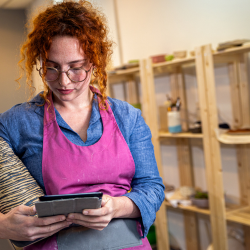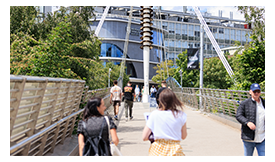-
Study
Study
Interested in studying at Northumbria? With 31,500 students, Northumbria is one of the largest universities in the country, offering courses on either a full-time, part-time or distance learning basis.
Discover more-
Undergraduate
- Undergraduate Study Degree
- Undergraduate Open Day & Events
- Application Guides
- Northumbria University UCAS Exhibitions
- Foundation Years
- Undergraduate Fees & Funding
- School & College Outreach
- Continuing Professional Development
-
Postgraduate
- Postgraduate Study Degree
- Postgraduate Research Degrees
- Postgraduate Open Days and Events
- Postgraduate Fees & Funding
- Flexible Learning
- Thinking about a Masters?
- Continuing Professional Development
- Change Direction
-
Student Life
- The Hub - Student Blog
- Accommodation
- Life in Newcastle
- Support for Students
- Careers
- Information for Parents
- Students' Union
- Northumbria Sport
-
-
International
International
Northumbria’s global footprint touches every continent across the world, through our global partnerships across 17 institutions in 10 countries, to our 277,000 strong alumni community and 150 recruitment partners – we prepare our students for the challenges of tomorrow. Discover more about how to join Northumbria’s global family or our partnerships.
Discover more-
Applying to Northumbria
- European Union
- Our London Campus
- Northumbria Pathway
- International Events
- Entry Requirements
- Agent Network
-
Northumbria Language Centre
- Faculty Requirements
- Acceptable English Requirements
- Pre-Sessional English and Study Skills
- Academic Language Skills Programmes (ALS)
-
International Fees, Funding & Scholarships
- International Undergraduate Fees
- International Undergraduate Funding
- International Masters Fees
- International Masters Funding
- International Postgraduate Research Fees
- International Postgraduate Research Funding
- International Money Matters
-
Life at Northumbria
- International student support
- The Hub - Student Blog
- Careers
-
International Mobility
- Current Northumbria Students
- Incoming Exchange Students
-
-
Business
Business
The world is changing faster than ever before. The future is there to be won by organisations who find ways to turn today's possibilities into tomorrows competitive edge. In a connected world, collaboration can be the key to success.
Discover more -
Research
Research
Northumbria is a research-rich, business-focused, professional university with a global reputation for academic quality. We conduct ground-breaking research that is responsive to the science & technology, health & well being, economic and social and arts & cultural needs for the communities
Discover more -
About Us
-
About Northumbria
- Our Strategy
- Our Staff
- Our Partners
- Student Profiles
- Alumni Profiles
- Leadership & Governance
- Academic Departments
- University Services
- History of Northumbria
- Contact us
- Online Shop
-
-
Alumni
Alumni
Northumbria University is renowned for the calibre of its business-ready graduates. Our alumni network has over 236,000 graduates based in 178 countries worldwide in a range of sectors, our alumni are making a real impact on the world.
Discover more - Work For Us
What will I learn on this module?
This level 5 Semester 2 module is designed to build upon your increasing knowledge of the interior design industry and allows you to start to identify your place within it. It will reinforce and build upon the importance of brand, customer and service in the design of successful commercial interior and spatial design. You will also start to focus upon site, place and the urban environment to better set project solutions in an appropriate context. The module allows you to build upon the skills and knowledge gained in previous design project modules and will allow you to develop your individual approach to design briefs through to a final design proposal.
The practical design project will be a staff-selected design competition, collaborative project or staff-initiated design brief, which will respond to current issues and opportunities and result in a resolved design solution that considers the resultant implications of brand, site, materials and construction set in an urban context. Project/s may deal with areas such as retail, leisure, exhibition etc. through the tactics of insertion and installation in response to site.
You will be challenged to consider and develop strategies related to brand, urban environment, manufacture, materials and processes, construction and technology, ergonomics and lighting in producing a resolved branded interior design solution.
Design projects will be set in the context of existing or new build and will ask you to engage with the exciting spatial challenges that interior design poses. A diverse range of topics relevant to the interior designer will be covered, including;
• Building re-use and re-interpretation – internal and external.
• Branding and branded interior environments.
• Service design as part of a full interior design proposal.
• Architecture, ‘shop fit’ and visual merchandising as part of a cohesive scheme.
• Construction and furniture detailing.
• Architectural technologies.
How will I learn on this module?
‘Interior Design Practice through Branded Environments’ is a project-based experiential learning module. You will learn in design studios, CAD labs and, where appropriate, workshops and virtual spaces in order to create a professional design-studio approach. The aim is to encourage the interaction of the student body, through peer learning which is regarded as a critically important factor in the learning process and will be facilitated through staff-led group tutorials, one-to-one sessions and reviews. We refer to this subject delivery approach as follows;
Northumbria X-Studio (Extended Studio):
The School of Design operates an extended studio approach (X-Studio) that embraces our physical studios and making workshops as well as our virtual spaces to create a flexible and rich environment that is responsive to our learners’ needs.
This dedicated approach has been developed over many years of continuous teaching innovation, research and industry collaboration. It has created a supportive extended studio culture that encourages our students to learn flexibly, dynamically blending their learning and University experience between physical and digital interactions both in real-time and online at their own pace.
We believe that this extended studio culture not only helps our students to become more confident autonomous learners but also prepares them for a dynamic design industry in which an extended studio philosophy is current practice.
Project brief/s will be introduced through a briefing session/s where the brief will be fully explained and you will have the opportunity to ask questions. The module is delivered via a combination of studio teaching, weekly seminars, tutor guided independent learning and student independent learning. Informal studio-based feedback will support your progress throughout the module. Where appropriate, external site visits will support design briefs and your understanding of the interior design process.
You will take part in a final review presentation of your design project work where you will receive final feedback from staff, which you will be required to document and process to advance future design projects and define your own learning. Summative assessment is through the submission of a design portfolio, which will enable you to learn through an enquiry-based/problem-solving learning methodologies and reflect the accumulation and integration of knowledge accrued over the module.
How will I be supported academically on this module?
Support and feedback will be provided by a variety of methods throughout design projects, starting at the briefing and concluding upon submission of each design project. Support includes;
Staff Contact
• Module tutors who provide academic support based upon industrial experience.
• Individual staff-student tutorials inform design project direction.
• Group tutorials enable staff to interact with students and encourage peer learning and support.
• Project briefs are normally introduced via a briefing session, where the brief is fully explained and explored by both staff and students.
• The eLearning Portal will be utilised to communicate all relevant module information.
Studio Contact Time
• Modules are delivered through a combination of lecture supported group tutorials and studio activity, practical demonstrations, studio teaching, guided and independent learning new skills are delivered through workshop activities.
• Studio feedback takes place to facilitate students’ development in the areas being studied, to allow formative feedback and the identification of examples of good practice and development areas to be considered.
• Independent study hours will be utilised to continue the development and progression of studio activity.
Peer and Independent Support
• Students are encouraged and expected to maintain a personal development plan (PDP) and are encouraged to take responsibility for their own learning.
• Studio based activity also supports the development of appreciation and evaluation of peers work.
What will I be expected to read on this module?
All modules at Northumbria include a range of reading materials that students are expected to engage with. The reading list for this module can be found at: http://readinglists.northumbria.ac.uk
(Reading List service online guide for academic staff this containing contact details for the Reading List team – http://library.northumbria.ac.uk/readinglists)
What will I be expected to achieve?
On successful completion of this module, you should be able to:
Knowledge & Understanding:
• (R+D) 2 -Demonstrate your ability to critically analyse and reflect in the evaluation of research evidence or material through research and experimental design development work.
• (DESIGN) 4-Demonstrate your advanced understanding of design methods and practical theories through the development of commercial interior design proposals.
Intellectual / Professional skills & abilities:
• (COM) 2 - Display evidence of critical thinking by conceiving, progressing, evaluating and communicating potential creative solutions to interior design briefs through computer aided design communication.
• (FLEXI) 3 - Demonstrate your understanding of functional, aesthetic, commercial or creative qualities in the creation of appropriate and considered design and specification.
Personal Values Attributes (Global / Cultural awareness, Ethics, Curiosity) (PVA):
• (PERSONAL) 2 - Demonstrate effective employability skills including organisational and project management through design research, development and final design proposal.
How will I be assessed?
A series of design projects will be carried out sequentially and grades given at the submission of each project. At the end of the module grades will be collated to provide a final mark for the module, which is 100% design project portfolio, incorporating 2D and 3D design work.
The assessment and feedback strategy is;
a. Formative Assessment
Project tutorials and staged reviews with tutors and peers will provide an opportunity for critique and formative direction. This will allow students to reflect upon their own work and act upon feedback prior to final submission. Verbal feedback is designed to help students to identify areas of success and/or further development to be considered.
b. Summative assessment
The project brief/s driving the module will identify the assessment criteria and submission requirements (deliverables) appropriate to the topic of the project. The assessable elements will consist of a project portfolio, which will enable students to demonstrate the process and technical skills developed throughout the module. In addition studio contact, observations and presentations will ensure tutors are able to assess the learners’ overall performance holistically against the learning outcomes for the module. A single grade will then be aligned to the submission based upon multiple deliverables.
c. Feedback strategy
Feedback will be delivered verbally at the point of each tutorial, where discussion will clarify future direction. Upon receiving summative assessment students will receive a grade reflecting achievement against the learning outcomes of the module. Students are encouraged to take ownership of their learning by recording feedback in order to reflect upon it as they engage in subsequent learning.
Pre-requisite(s)
Level 4 or Equivalent Experience
Co-requisite(s)
N/A
Module abstract
‘Interior Design Practice through Branded Environments’ builds upon your increasing knowledge of the interior design industry and allows you to start to identify your place within it. It will reinforce and build upon the importance of brand, customer and service in the design of successful commercial interior and spatial design proposals. You will also focus upon site, place and the urban environment to better set project solutions in an appropriate context.
You will be challenged to consider and develop strategies related to brand, urban environment, manufacture, materials and processes, construction and technology, ergonomics and lighting in producing a resolved branded interior design solution.
Design projects will be set in the context of existing or new build architecture and will ask you to engage with the exciting spatial challenges that interior design poses.
Learning will be based in our industry standard design studios, CAD lab, photography studio, workshops and virtual studios, to give you the practical and observational skills and subject knowledge required for placement or employability in industry.
Course info
UCAS Code W250
Credits 40
Level of Study Undergraduate
Mode of Study 3 years full-time or 4 years with a placement (sandwich)/study abroad
Department Northumbria School of Design
Location City Campus, Northumbria University
City Newcastle
Start September 2024 or September 2025
All information is accurate at the time of sharing.
Full time Courses are primarily delivered via on-campus face to face learning but could include elements of online learning. Most courses run as planned and as promoted on our website and via our marketing materials, but if there are any substantial changes (as determined by the Competition and Markets Authority) to a course or there is the potential that course may be withdrawn, we will notify all affected applicants as soon as possible with advice and guidance regarding their options. It is also important to be aware that optional modules listed on course pages may be subject to change depending on uptake numbers each year.
Contact time is subject to increase or decrease in line with possible restrictions imposed by the government or the University in the interest of maintaining the health and safety and wellbeing of students, staff, and visitors if this is deemed necessary in future.
Your Learning Experience
Find out about our distinctive approach at
www.northumbria.ac.uk/exp
Admissions Terms and Conditions
northumbria.ac.uk/terms
Fees and Funding
northumbria.ac.uk/fees
Admissions Policy
northumbria.ac.uk/adpolicy
Admissions Complaints Policy
northumbria.ac.uk/complaints














